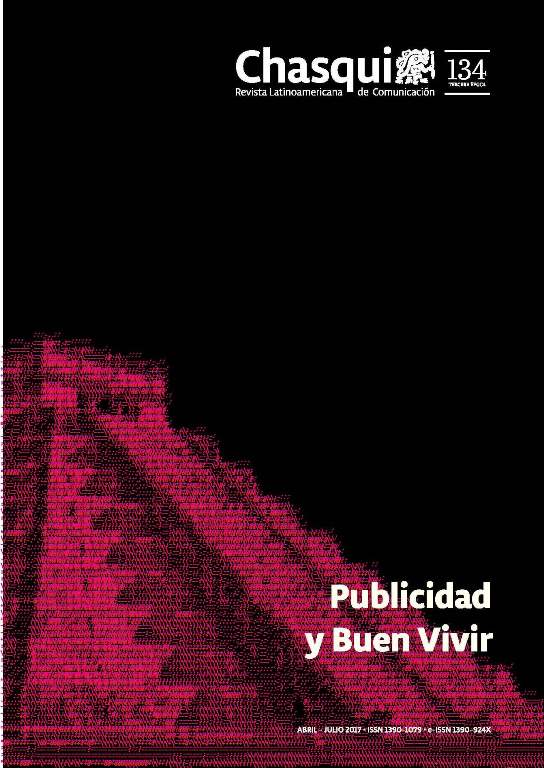O Anjo da Noite, gothic horror and the Brazilian social tensions in the 1970s
DOI:
https://doi.org/10.16921/chasqui.v0i134.2599Keywords:
cinema, Brasil, gothic horror, 1970’s, Walter Hugo KhouriAbstract
This paper proposes a brief analysis of the Brazilian film O Anjo da Noite (The Angel Of The Night, Walter Hugo Khouri, 1974). The analysis seeks to understand how this film, inspired by the Gothic literature tradition of the eighteenth century and in the classic The Turn of the Screw (Henry James, 1898), conducted a sophisticated reflection on sexual and social anxieties that challenged the Brazilian society at the time. The work analyzes the dialogue undertaken by Khouri’s movie with the discursive operations of gothic horror fiction, suggesting that the director used that style (emerged during the decadence of the Ancien Régime, in the eighteenth century) to represent Brazilian social tensions in the 1970s.References
Abreu, N.C.P. (2006). Boca do Lixo: Cinema e Classes Populares no Brasil. Campinas: Ed. Unicamp.
Alves, L. (2012). O valor da brancura: considerações sobre um debate pouco explorado no Brasil. Cadernos Cenpec, São Paulo, 2(2), 29-46. Recuperado de http://bit.ly/2mUJ9l1.
Basinger, J. (1993). A Woman’s View: How Hollywood Spoke to Women (1930-1960). London: Chatto and Windus.
Canepa, L. (2011). Filmes brasileiros de mulheres paranoicas: as segundas mulheres e o horror no cinema brasileiro. E-Compós - Revista da Associação Nacional de Programas de Pós-Graduação em Comunicação. Brasília, 14(1), 1-17. Recuperado de: http://bit.ly/2mUJcxd.
Canepa, L. (2012). Tecnologias da comunicação, horror e ficção científica: O caso de três filmes brasileiros. Revista Contemporânea - Comunicação e Cultura. Salvador, 10(1), 223-238. Recuperado de http://bit.ly/2m78vx1.
Canepa, L. (2015). Experiências brasileiras com a ficção gótica: Khouri, Christensen e o gótico feminino. En Aguilera, Y. (Ed.). Imagem e Exílio: Cinema e Arte na América Latina (pp. 150-172). São Paulo: Discurso Editorial.
Canepa, L. (2016). Configurações do horror cinematográfico brasileiro nos anos 2000: continuidades e inovações. En Cardoso, J.B.C.; Santos, R.E. (Eds.). Miradas sobre o cinema ibero latino-americano contemporâneo (pp. 121-144). São Caetano do Sul: USCS. Recuperado de http://bit.ly/1Uu36rw.
Carroll, N. (1999). A filosofia do horror ou paradoxos do coração. Campinas: Papirus.
Delamote, E. C. (1990). Perils of the Night: A feminist study of the nineteenth-century gothic. New York: Oxford Universty Press.
Doane, M. A. (1987). The Desire to Desire: The Woman’s Films of The 1940’s. Bloomington: Indiana University Press.
Dunker, C. I. L. (2015). Mal-estar, sofrimento e sintoma: Uma psicopatologia do Brasil entre-muros. São Paulo: Boitempo.
Dupee, F.W. (1945). The Question Of Henry James. Nova Iorque: H. Holt & Company.
Elsaesser, T. (1987). Tales of Sound and Fury: Observations on the Family Melodrama. En Gledhill, C. (1987) (Ed.) Home is Where the Heart is: Studies in Melodrama and the Woman’s Film. London: BFI.
Enne, A. L. (2008). Romances de segunda esposa: o Brasil entre a tradição e a modernidade. Trabalho apresentado ao Grupo de Trabalho Cultura das Mídias, no XVII Encontro da Compós. UNIP, São Paulo. Recuperado de: http://bit.ly/2nKnXvC.
Ferreira, J. (1979, marzo 5). Os Mundos paralelos de Khouri. Jornal Folha de São Paulo: São Paulo.
Greven, D. (2011). Representations of Femininity in American Genre Cinema: The woman´s film, film noir and modern horror. Nova Iorque: Palgrave Macmillan.
Gutman, G. (2005). The Turn of the Screw: Sobre Henry James, William James, cérebros e fantasmas. Alea. Rio de Janeiro, 7(1), 79-100. Recuperado de http://bit.ly/2m78GZd.
Hanson, H. (2007). Hollywood Heroines: Women in Film Noir and The Female Gothic. Londres/Nova Iorque: I.B.Tauris.
James, H. (2006 [1898]). A Volta do Parafuso. São Paulo: Landmark.
Jancovich, M. (2007). Crack-Up: Psycologichal Realism, Generic Transformation And The Demise Of Paranoid Woman’s Films. The Irish Journal of Gothic and Horror Studies. 3. Recuperado de http://bit.ly/2nx76gg.
Puppo, E. (Ed.) (2009). O Horror no Cinema Brasileiro. São Paulo: Heco Produções. Recuperado de http://bit.ly/2mxVdoX.
Ramos, F. (2001). A coisa da imagem e a preponderância do afeto. En Puppo, E. (Ed). Walter Hugo Khouri Retrospectiva – Meio século de cinema. São Paulo: Heco Produções, 2001. Recuperado de http://bit.ly/2mUJK6k.
Sá, D. S. (2012). The Daughters of Fire: Walter Hugo Khouri's female gothic. Ilha do Desterro. Florianópolis, 62, 293-318.
Salles Gomes, P. E. (1981). Rascunhos e exercícios. Crítica de cinema do Suplemento Literário. 1. Rio de Janeiro: Paz e Terra/Embrafilme.
Santos, A.P. A. & França, J. (2016). A representação da personagem feminina na literatura gótica brasileira. Trem de Letras. Alfenas, 2016, 1(3), 04-14. Recuperado de http://bit.ly/2nxghO2.
Safatle, V. (2015). Prefácio: Depois dos muros de Alphaville, o mato. En Dunker, C. I. L. (2015). Mal-estar, sofrimento e sintoma: Uma psicopatologia do Brasil entre-muros (pp. 9-12). São Paulo: Boitempo.
Singer, A. (2012). Os sentidos do Lulismo: Reforma gradual e pacto conservador. São Paulo: Cia das Letras.
Singer, A. & Loureiro, I. (2016). Apresentação: Elementos para uma cartografia do desenvolvimentismo lulista. En Singer, A. & Loureiro, I. (Eds). A que ponto chegamos? (pp. 9-21). São Paulo: Boitempo.
Xavier, I. (2001) O Cinema Brasileiro Moderno. São Paulo: Paz e Terra.
Xavier, I. (2003). O Olhar e a Cena: Melodrama, Hollywood, Cinema Novo, Nelson Rodrigues. São Paulo: Cosac e Naify.
Downloads
Published
Issue
Section
License
- Authors retain copyright and grant the journal right of first publication with the work simultaneously licensed under a Creative Commons Attribution-NoDerivs License (CC BY-ND) that allows others to share the work with an acknowledgement of the work's authorship and initial publication in this journal.
- Authors are able to enter into separate, additional contractual arrangements for the non-exclusive distribution of the journal's published version of the work (e.g., post it to an institutional repository or publish it in a book), with an acknowledgement of its initial publication in this journal.
- Authors are permitted and encouraged to post their work online.

